Twitter For Nonprofits: How To Establish & Grow Your Presence
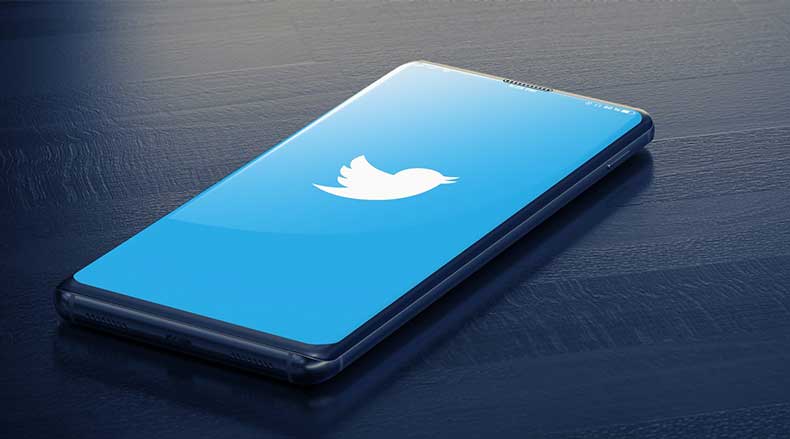
Twitter is a powerful network that gives everyone a voice online. For nonprofits, Twitter isn’t just a great way to share relevant, time-sensitive, and important news with your followers. It’s also a direct line of communication with people who are invested in the cause you serve – whether they’re already committed donors or just finding you for the first time. If you are serious about establishing your voice and gaining new supporters, we think Twitter for nonprofits is a great way to gain traction.
Twitter can be central to a nonprofit’s online fundraising and social marketing campaigns. But we also know that, when you’re doing a million other things, it might be the last thing you think about. Never fear! We’vpe jotted down a Twitter for nonprofits tutorial to help your organization know how to establish and grow your online presence.
- When & How Much Should You Tweet?
- Should Nonprofits Use Tweet Scheduling?
- What Should You Tweet?
- What Are The Common Mistakes With Twitter For Nonprofits?
- Getting Started With Twitter For Nonprofits
When & How Much Should You Tweet?
There are lots of people studying Twitter behavior, trying to find out how to create content that is engaging. Sprout Social actually created a guide to the best times to post on social media in 2020, with insights specifically for nonprofits. They found that posts between 8 AM and 3 PM CST, Monday – Friday are the safest times for engagement. Wednesday at 7 AM is the best time for nonprofits to tweet. In general, the nonprofit audience seems to be more engaged earlier in the day with engagement falling off after normal working hours.
The weekend, specifically Saturday, is the worst time for engagement with nonprofits on Twitter. That means you can take a breather from Friday evening to early Monday morning. But as we’ll share later, it’s worth testing out tweets outside of peak times for the rest of the sector. You may find that your audience is different from the norm. The only way to find out is by trying a late night or weekend tweet and see what happens.
Best & Worst Engagement For Nonprofits On Twitter
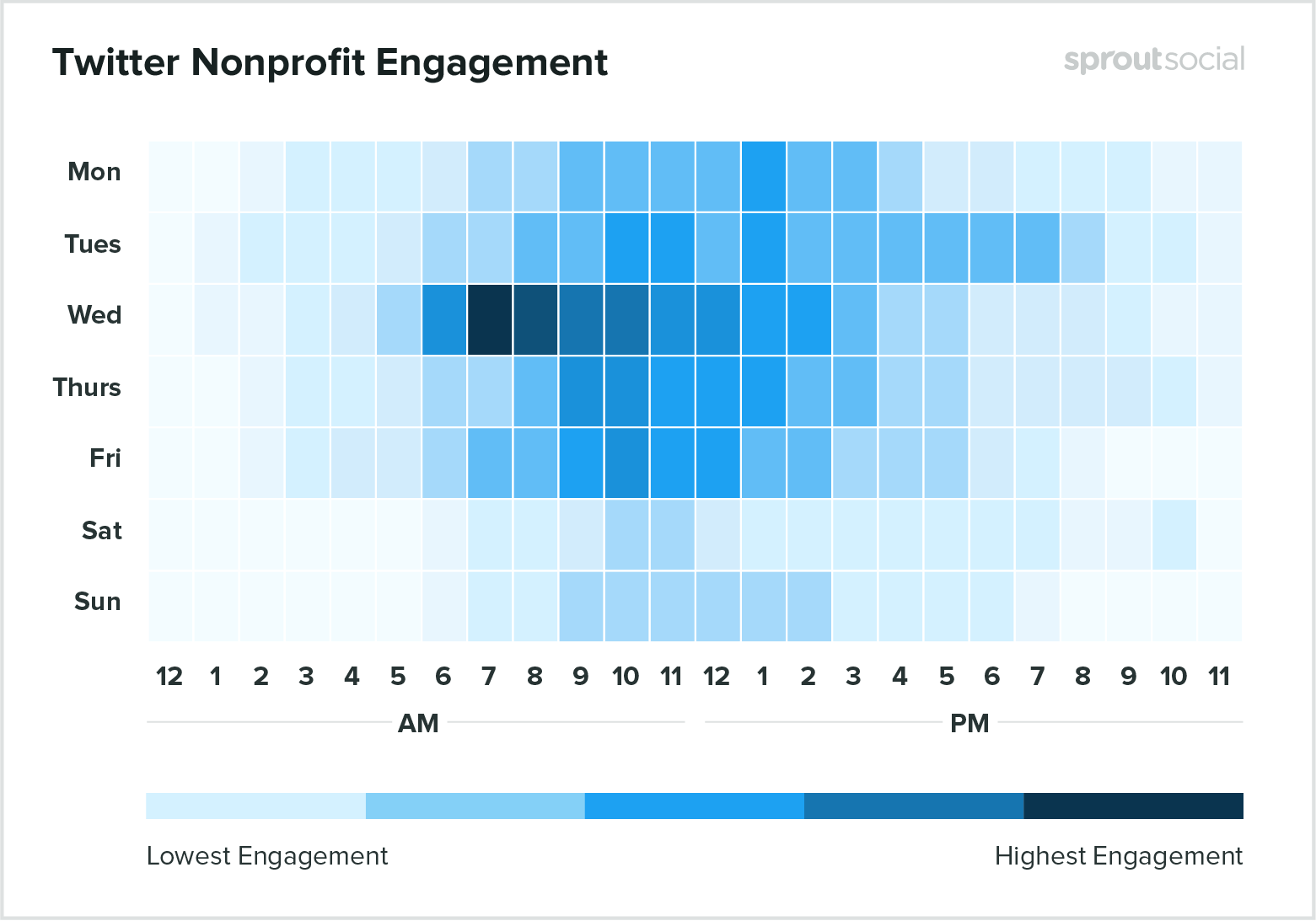
Image: This heatmap from Sprout Social shows the best and worst times for nonprofits to Tweet.
In terms of how often to tweet, we’d recommend posting at least 3-5 tweets every day. That may sound like a lot, but remember that you can use strategies like threads and retweets to establish a presence without thinking of several separate tweets for each.
Should Nonprofits Use Tweet Scheduling?
When it comes to your nonprofit’s Twitter presence, it’s important to be consistent. You’ll build the best relationship with your followers if you tweet at least once per day. But unless you have a team member or volunteer who can spend this much time with social media, it will be hard to keep up with tweeting throughout the day.
That’s why we recommend planning out your tweets each week. This can help make sure you’re being consistent while also balancing out the types of tweets you’re sharing. You don’t want every tweet to be a fundraising appeal. But if you plan your tweets well, you can engage your audience leading up to a big ask. Here’s an example we put together of a nonprofit planning out their tweets for the week.
Example Of A Nonprofit Twitter Schedule
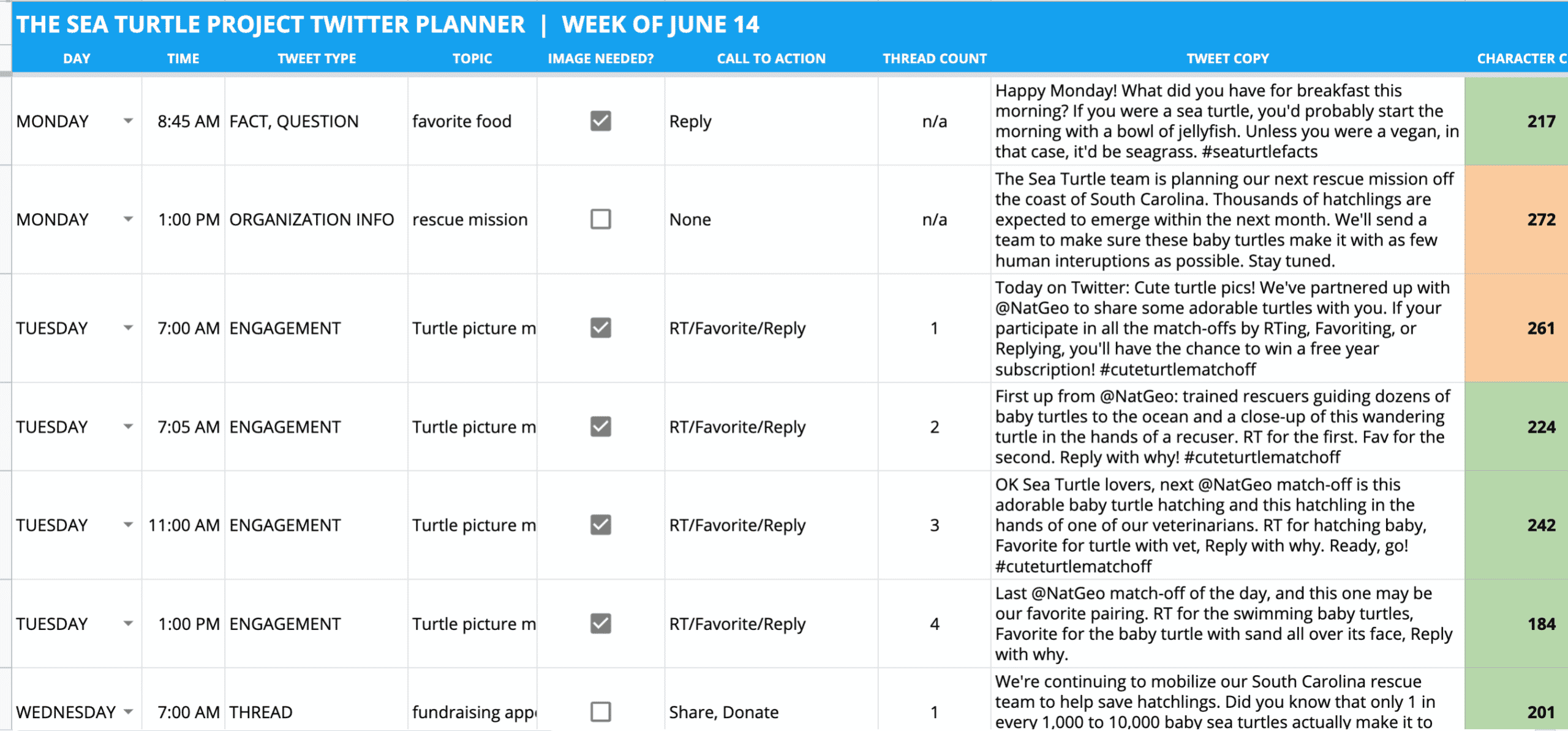
In this example, you can see the plan is to use engaging tweets on Monday and Tuesday leading up to a big ask on Wednesday—right during the peak time for engagement.
While you can use spreadsheets to schedule your tweets, we recommend that you also consider a Twitter scheduling software, as well. Many social media management software’s have a tweet scheduler already built-in, and you can set the exact time you want them to publish. That way, you can spend just an hour or so each week planning out your tweets. It’s worth considering adding a social media management tool in your online fundraising software suite.
Whether you stick with spreadsheets or invest in a social media management software, we’ll share tips and best practices for scheduling your tweets.
Benefits Of Scheduling Your Tweets
Creating a plan will ensure that your nonprofit’s presence on Twitter is targeted and consistent. Targeted tweets help you engage your audience in a strategic way, cultivating new followers and new donors to grow your nonprofit’s impact.
Instead of trying to think of new things to say in the moment, you can plan ahead and drive your followers to specific fundraising campaigns or towards specific online donation pages. You aren’t just reacting to the conversation, you’re leading it.
Consistent tweets keep you in front of your audience and keep their attention focused on your cause. In a world with thousands of messages competing for our attention, making your Twitter presence consistent and expected will help boost your online fundraising and awareness efforts.
Best Practices For Scheduling Your Tweets
Ideally, we’d recommend posting 3-5 scheduled tweets every day – that’s about 30 tweets a week, or 115 a month. But one tweet per day is also a great starting point.
Whatever number works for your organization, make sure you are still able to maintain variety. Posts that are all about the same thing are just as bad as spammy emails and will be just as ineffective as if you weren’t tweeting at all.
While it may seem daunting to create over 100 authentic tweets in one sitting, you’ll be surprised how much time it saves compared to trying to craft a new set of tweets every day.
Here are some other tips to help you create your Twitter scheduling plan:
Know What You’re Talking About
Before you do anything, it’s important to know what you’re trying to accomplish. Do some brainstorming to determine your strategic goals and known assets first. What is the objective of your social media campaign? How will meeting this goal impact your work? What are the videos, photos, or short testimonials that you have on hand to better engage your audience? And don’t forget to decide on a #hashtag that’s relevant to your organization and/or campaign.
Get Specific & Be Creative
Once you know what you’re writing about, make sure you’re specific. Many people who will see your tweets may be new to the mission and vision of your organization, so you want them to know what they’re actually getting into if they retweet your post or donate.
And just because you have to keep it at 280 characters, it doesn’t mean you have to be vague or boring. Thinking about creative ways to portray the same message can be a great way to get multiple tweets written at once.
Repurpose, Don’t Reuse
With over 500 million tweets going out every day – or almost 21 million every hour – it’s inevitable that even your most well-crafted and creative tweets will get lost among the fray sometimes. That’s why it’s completely acceptable to post the same link or video more than once throughout your social media campaign – just make sure you package the same message a bit differently each time. Maybe you point to a link at first by asking a question and then with a killer video or testimonial. There are lot’s a great ways to repurpose the same message, which can definitely save you time when you’re trying to write bulk tweets for scheduling.
Don’t Try To Do Too Much Too Quickly
Rather than creating a tweet schedule for the next six months of your social media campaign, start with just one month. That way, you can review the results and feedback of your efforts and adjust your tweet schedule to make an even stronger connection in the next month.
Continue To Engage With Your Audience In Real-Time
We think that scheduling tweets is an essential tool in helping you draft a consistent presence with your target audience. But it doesn’t let you off the hook when it comes to live engagement on Twitter.
As you’re getting started, a good rule of thumb is to post 2-3 live responses and updates every day. Don’t worry, this can be as easy as responding to tweets or retweeting posts you like.
Try Social Media Management Software
After you’ve written all your tweets, scheduling them is easy. We recommend marketing automation services like HubSpot, HootSuite, or Sprout Social.
These softwares make it easy to pre-schedule all kinds of social media posts, including on Twitter. Plus, with HootSuite for nonprofits, you can get 50% off for your plan.
When it comes to polishing your Twitter strategy, remember that social media marketing tactics are always a moving target. We recommend trying different things to see what works best for your organization. Just make sure you monitor your performance. That way you can see how many Tweets your followers respond to in a day, what times they are most active, and even what content they like best. This information will help you know what your followers respond to the most and help you optimize your strategy.
What Should You Tweet?
Now that you know how often to tweet, it’s time to think about what you’re actually going to tweet. When it comes to the content you post on Twitter, variety is key.
Research shows that Twitter users like a mix of images, videos, questions, and calls to action. Similarly, it is good practice to produce a mix of your own content, curated content from other sources, and organic interactions with your followers. We recommend that each of those tweet types represent about one third of your output each.
Consider including hashtags with your tweets. They help establish your presence with the larger Twitter network. Using them can insert you into trending topics, like #GivingTuesday, and create buzz around a specific event or campaign that you group together using a simple #name.
We’ve put together some specific ideas to get your creativity flowing.
Ask a question.
Remember that Twitter is all about conversation. Write a concise and compelling question to increase donor engagement in 280 characters or less!

Image: Asking a question is a simple way to invite your followers to engage.
State a fact.
The best donors are the informed donors. Use Twitter to share a powerful fact that will help your followers see the urgency and importance of your cause.
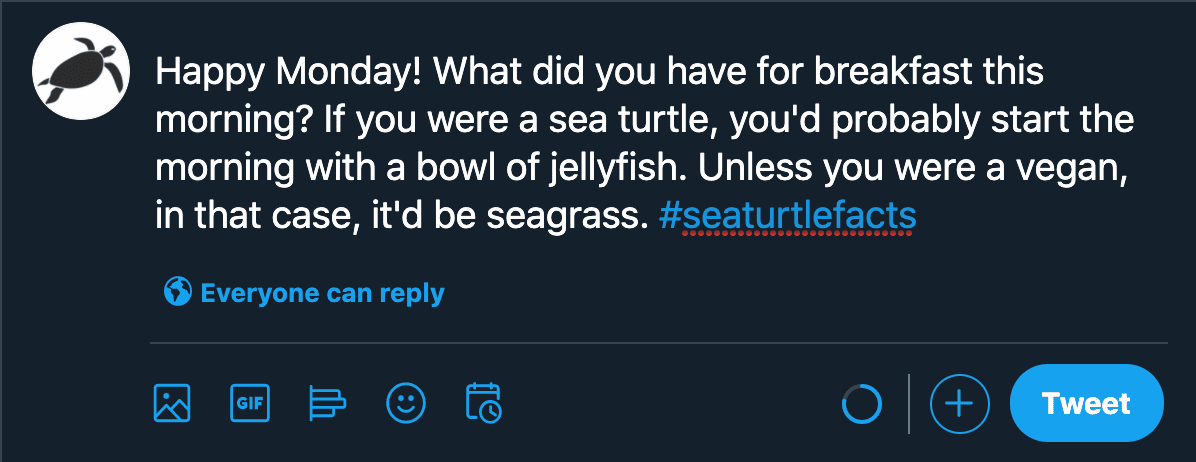
Image: You can share facts in your tweets to engage and educate your followers about your cause.
Get creative with engagement.
Twitter has several tools you can use to boost engagement. Try different features like polls, gifs, and emojis to catch the attention of your followers.

Image: Twitter built-in engagement tools include images, gifs, polls, and emojis.
Leverage partnerships.
Many other nonprofits and businesses are open to social media collaborations. For-profit companies call this cause marketing. It’s a way for businesses to nurture corporate social responsibility, and it can benefit you by increasing your reach. Make sure to tag your partner and negotiate any terms ahead of time. For example: Will they retweet you? Favorite your tweet? Publish their own tweet with a link to your profile? Make sure these terms are clear ahead of time so the partnership is mutually beneficial.
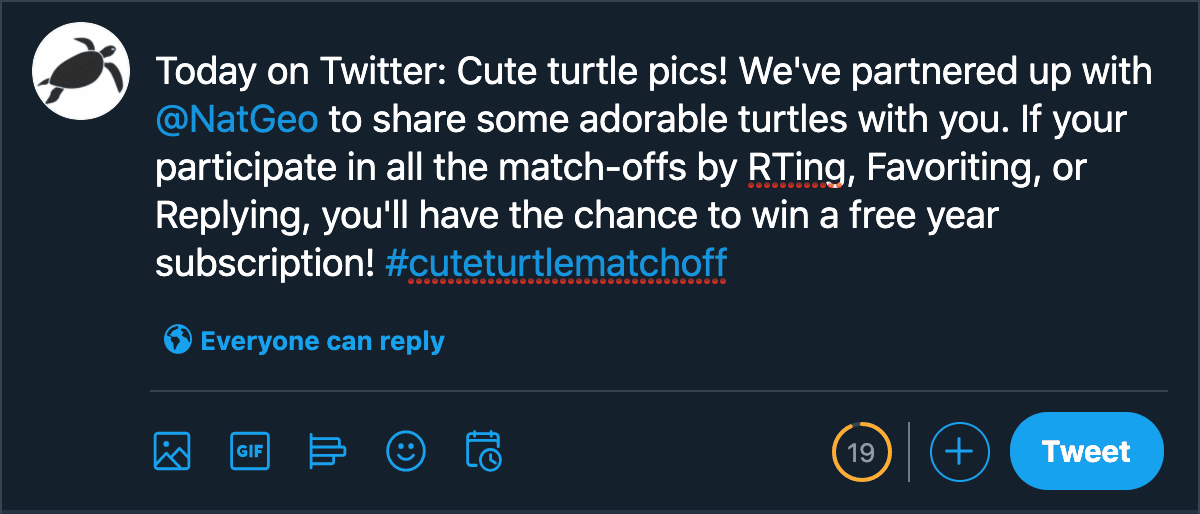
Image: You can work with a corporate partner to boost your reach.
Add a Picture.
Tweets that include a strong image are much more likely to be shared than basic text tweets. Since Twitter makes it easy to attach photos from your other sites, sharing a picture is a great way to catch people’s eye and build brand awareness across multiple social media platforms.
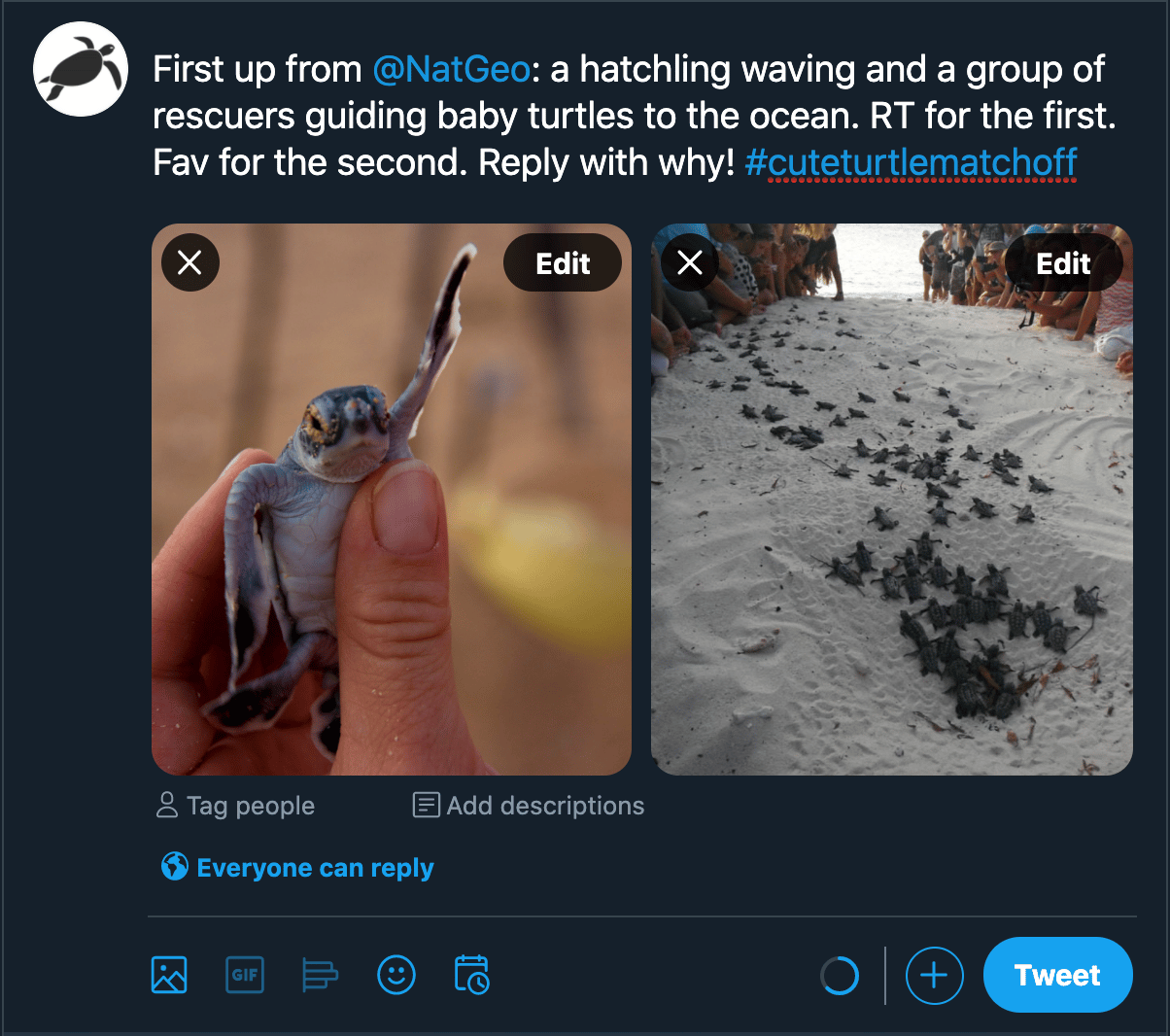
Image: You can easily share images with your tweets and invite your followers to engage.
Start a thread.
One way to get around the notorious 280 character limit? Use a thread to post several tweets in a row on the same topic. Twitter threads are a great way to provide updates on your fundraising campaigns or other projects and also share information with your audience.
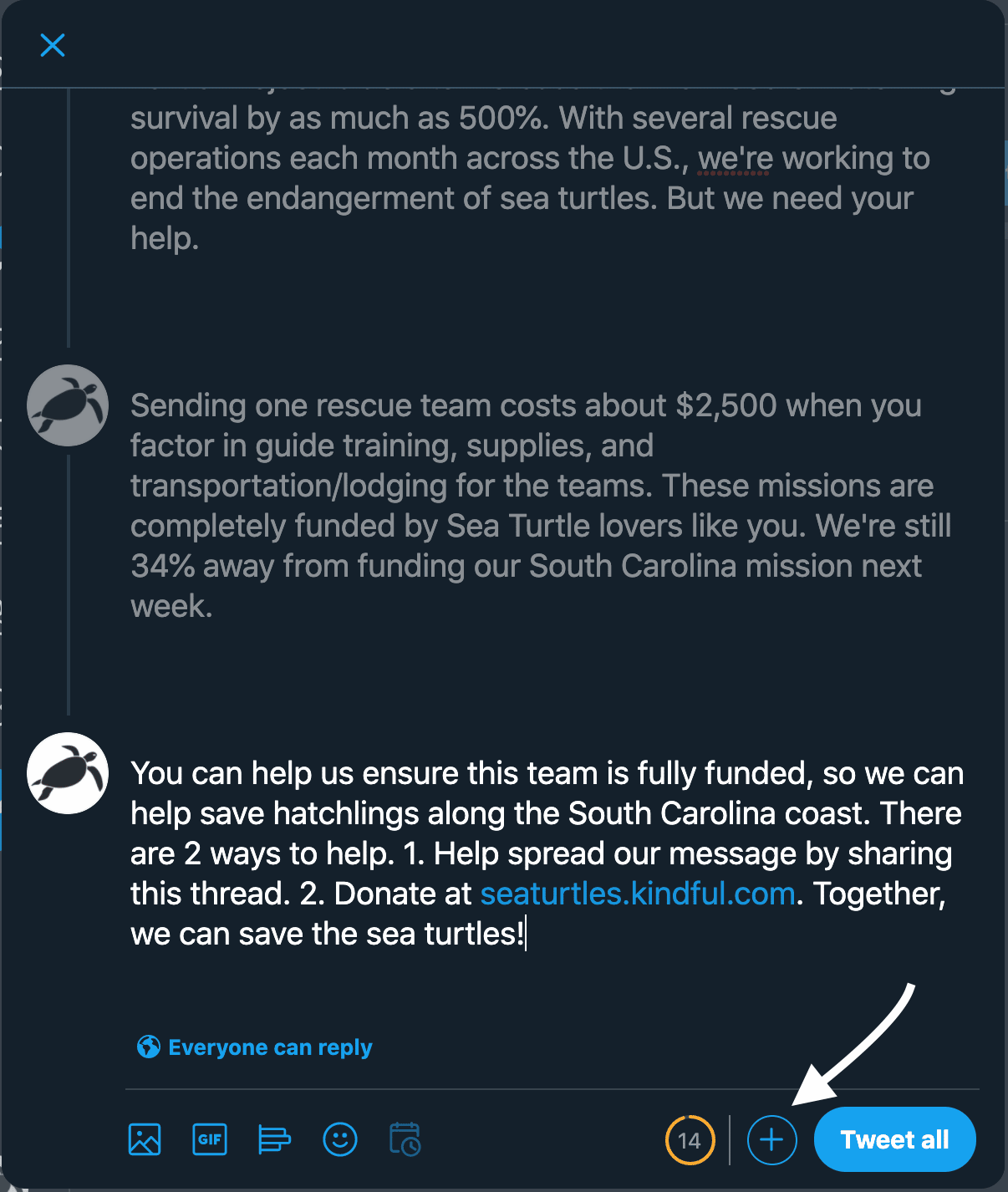
Image: Twitter allows you to publish threads to connect a series of tweets together. Simply press the plus button to add another.
Have a call to action.
With the other three types of tweets featuring heavily on your feed, a well-timed solicitation can have a huge impact for nonprofits on Twitter. Keep it within the character limit and inspire urgency and action with your support network.
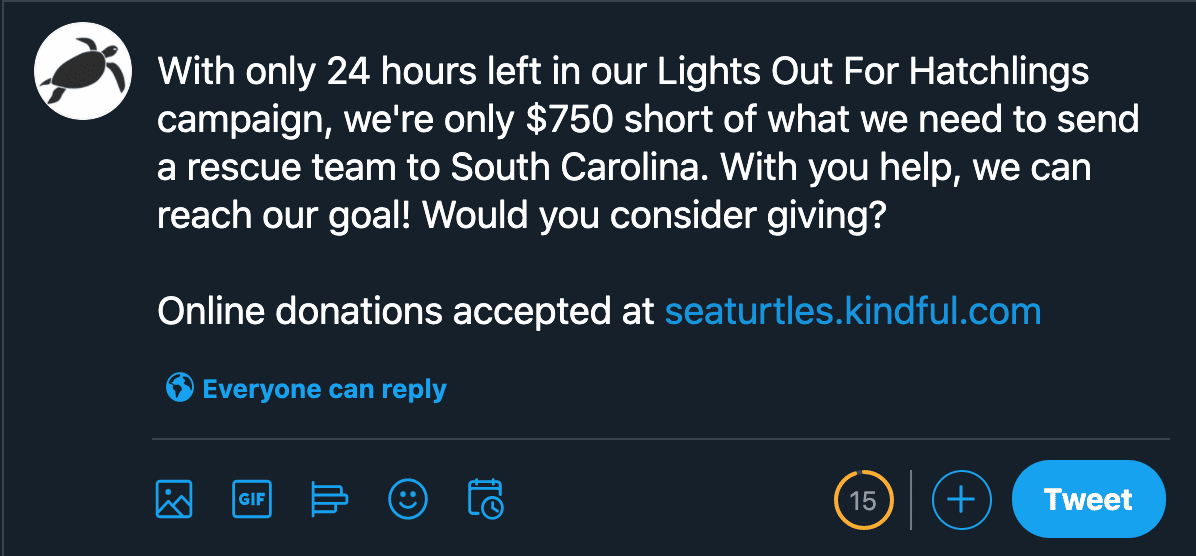
Image: Twitter is a great place to share updates on your fundraising campaigns and ask for support.
These tips will guide you to establishing or growing your nonprofit’s Twitter presence. If you’re having trouble getting started, remember that the best way to learn is simply to jump in and give it a try. It’s okay if some of your early tweets fall flat. With practice, you’ll learn what works and what doesn’t. It can also help to look at some examples of other nonprofit Twitter accounts.
What Are The Common Mistakes With Twitter For Nonprofits?
As you experiment and try new strategies, you’ll probably make some mistakes. And that’s okay! We can’t warn you of every possible nonprofit Twitter failure, but we did put together some common mistakes you may run into.
Not Trying At All
Without a doubt, the biggest mistake nonprofits can make when it comes to Twitter is to overlook the vast potential it holds in your capacity to reach out and spark donor engagement. You may not completely understand how things like hashtags and retweets work. You may feel overwhelmed by the 280-character limit. The truth is, the bigger mistake would be not trying at all.
Solution: Start an account for your nonprofit if you don’t already have one, and just start tweeting.
Not Engaging With Your Audience
The beauty of Twitter for nonprofits lies in its power to connect you with your target audience immediately and in real-time. Engagement is the heart and soul of Twitter! Unfortunately, too many nonprofits make the mistake of simply posting general broadcasts or fundraising appeals instead of actually engaging with followers or other people on Twitter.
Solution: Make sure you engage your followers with retweets and replies.
Not Using Hashtags
Not only do hashtags connect you with the broader conversation in Twitter, they allow your followers to bring their friends into your social media campaign as well. Create a unique hashtag for your nonprofit fundraising event or initiative. This will encourage your supporters to advocate for your cause and even help you raise money.
Solution: Include hashtags in your tweets that are relevant to your organization, cause, or campaign.
Not Updating Your Twitter Strategy
Setting a content schedule for your Twitter presence is vital, but if your pre-determined plan of attack doesn’t seem to be working, it’s time to consider making some changes.
One of the biggest mistakes that nonprofits make when it comes to any social media campaign is continuing with a strategy that has proven to be ineffective. That’s why it’s important to determine goals, benchmarks, and measuring tools before you start anything. How will you measure if your Twitter strategy is working? Follower count? Engagement? Donations from tweets?
However you measure success, if you’re not meeting your benchmarks, it’s time to consider trying something new.
Solution: Set up goals and metrics to track to see if your Twitter strategy is successful. If you don’t see improvements, try something new.
Not Being Consistent With Your Brand
It may not seem like a big deal, but the way your Twitter looks does matter. The level of professionalism and care you take to present yourself on Twitter does affect engagement.
Pay attention to your profile picture and cover image. Keep everything in line with your organization’s brand standards, use high resolution photos that won’t get pixelated, and always make sure your images highlight your message, not distract from it. And while Twitter isn’t as image-based as Instagram, that doesn’t mean your tweets have to always be text-only.
Solution: Make sure your profile picture, cover image, and any images you post are high quality and consistent with your brand.
Getting Started With Twitter For Nonprofits
When it comes to using Twitter for nonprofits, the most important thing is that you establish a strong, consistent presence through regularly tweeting and interacting with your followers. Make sure your strategy includes this criteria, and simply get started! Measure your performance, note your mistakes, and make changes as necessary. It will always be a #workinprogress.
We recommend following Twitter’s official nonprofit account @nonprofits to see great examples of organizations using Twitter.
Now that you know the Twitter basics, upgrade your Facebook and Instagram presence with our 5 essential nonprofit social media strategies.
5 Essential Nonprofit Social Media Strategies For Organic Growth
Schedule a live demo with Bloomerang, and we’ll show you how easy it is to create and automate reports, utilize online and offline fundraising tools, quickly integrate and access all your data, and ultimately create more time to engage your donors.